15 Absolute Best Tips For Boiling Potatoes
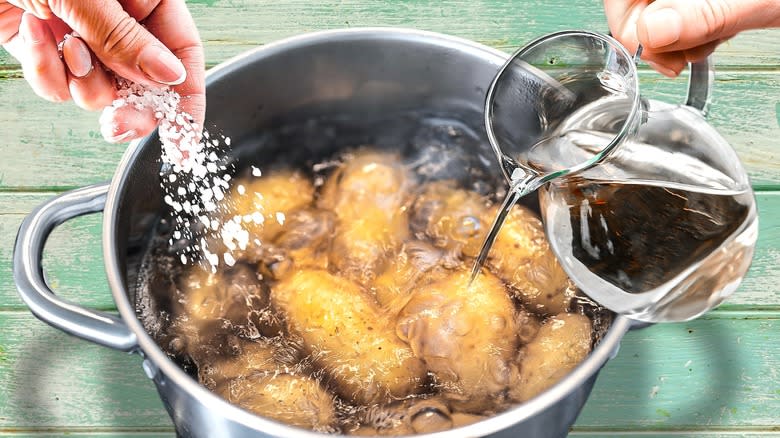
Potatoes originated in South America, but they've since become a global culinary staple, in part because they can be prepared in so many different ways and fit in seamlessly with so many different cuisines. One of the easiest ways to prepare potatoes is to boil them — doing so for long enough will undoubtedly cook them through and provide you with a fine tuber to enjoy with any accompaniment you choose.
But that's not to say that the process can't be improved upon. Boiling potatoes any old way won't yield an unsavory result, but we're in the business of maximizing the enjoyment of consuming food, so we came up with a few tips on how to boil potatoes for the best possible results. From the selection process — potato types should differ based on whether you're baking or boiling them — to the various additional ingredients you can use in the cooking water, we'll guide you through a list of best practices based on previous articles published on Tasting Table and partner publications and on the author's personal experiences in cooking with potatoes.
Read more: 23 Types Of Potatoes And When To Use Them
Boil Starchy Ones Whole
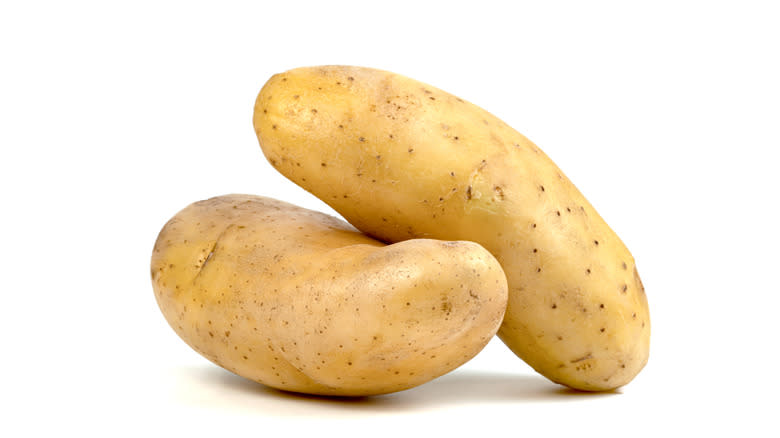
Quite aside from the fact that there are more than 3,000 different varieties of potato in the world, most of which the common human will never try, there are also several different types of potato that we use regularly for culinary applications. The type we want to talk about here is the starchy potato, which includes the likes of russet potatoes, King Edward potatoes, and even sweet potatoes.
Starchy potatoes aren't better or worse than any other type — they just have different properties and behave in a different way during the cooking process. With boiling in particular, chopped starchy potatoes tend to absorb excess amounts of water, causing them to fall apart and lose almost all their flavor. The solution to this problem is simple: Boil starchy potatoes whole, with the skin on. This method will keep the water out and the pulp intact. Although this means you'll have to remove the skin from a hot potato (if you're making mashed potatoes, for example), the task is not as hard as it sounds. Just cut the potatoes in half and scoop the pulp out of the skin with a spoon.
Start Them In Cold Water
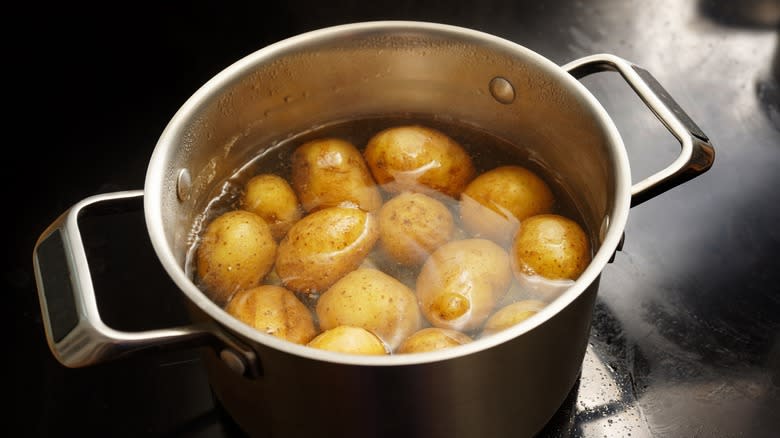
We all love a good time-saving hack in this wild and crazy world. But sometimes, there are no shortcuts in good cooking, and one such instance is in the process of boiling potatoes. While many of us have committed the sin of adding hot water to a pot to boil potatoes and likely will again, it's important to note that this is not the most effective way to cook if you want to draw out the best flavor and texture.
Rather, potatoes need to be started off in cold water, especially if you're cooking them whole. This is because potatoes are dense, which means they need a lot of time to cook through. Boiling water risks cooking the outside of the potato quickly while the inside remains firm. As a result, the exterior will become mushy before the interior is even soft. For a more even distribution, use cold water.
Avoid Overboiling Them
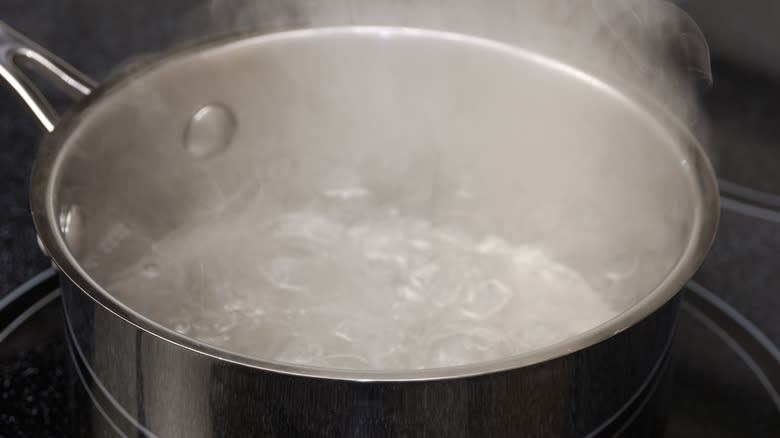
It may seem impossible to overcook potatoes while boiling them. With all that water involved, they certainly won't get burnt. But you always have to look out for the mush factor, which is the main mistake we face when boiling potatoes. Perhaps we shouldn't be boiling them at all. Not a full boil, at least. A regular boil at 212 F will probably suffice, as anything more than that may cause the outside of the potato to overcook while the inside stays raw –- a common problem in potato boiling. And since "regular boil" is admittedly a vague term, we suggest using a thermometer to check the temperature of the water or bringing it to a boil and then lowering the heat to a more sustainable simmer.
But let's say you have all that down — how do you know when the potatoes are actually cooked through? The boiling process doesn't really cause them to change color, so you can't tell just by looking at them. For that, you'll have to stick a fork in it — if it pierces through the potato without resistance, your job is done.
Give Them A Salt Crust
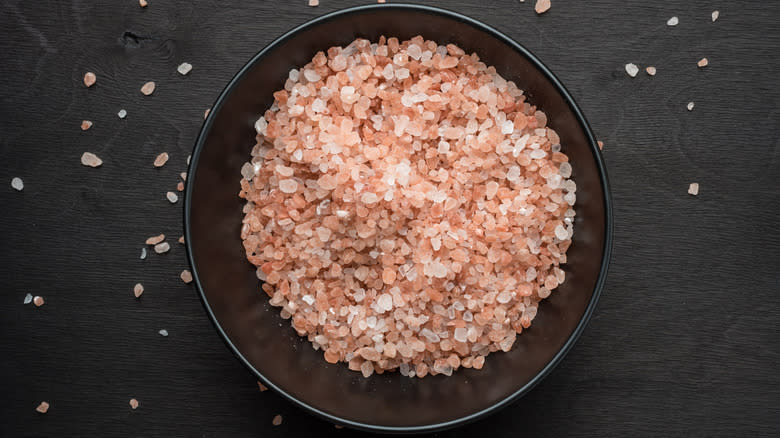
Boiled potatoes can sound overly simple and boring. And most of the time, that's true. More often than not, boiling a potato is just the first step in a larger recipe, where the tuber is then combined with additional ingredients and cooked in some other way. But we're here to tell you that there is a way to spruce up your boiled potatoes without having to do anything extra aside from adding the right kind of salt at the right time.
This action yields a delicious salt crust that forms on the potatoes after the water boils off, as long as you've added enough salt to begin with. In fact, you will need more salt than you're probably used to for this recipe –- up to ½ cup of salt per pound of whole potatoes and only enough water to cover the potatoes. The pot then needs to be on the heat until all the water has evaporated and for a few more minutes beyond that, which will give the salt enough time to crystallize on the potatoes. You will end up with crispy and salty tubers on the outside and light and fluffy on the inside.
Add A Dash Of Vinegar
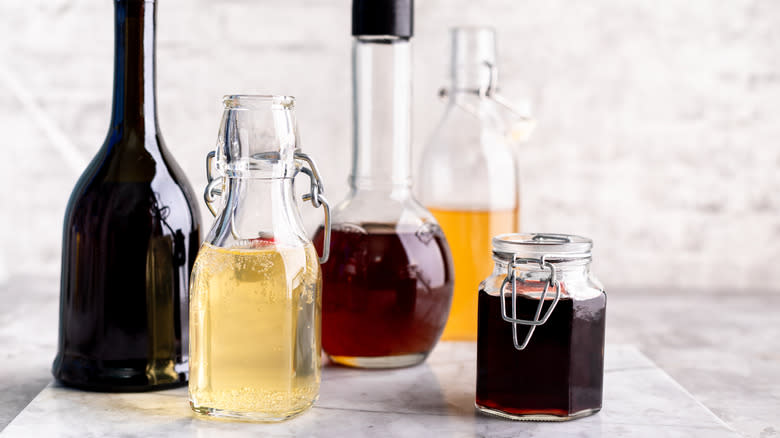
Boiling potatoes is nothing like making a poached egg, but vinegar can come in handy nonetheless. Just as with the eggs, the vinegar can help the potatoes retain their shape as they cook away in the hot water. This is because the vinegar will cause the potato to develop a sort of shield on its outer layer, keeping the rest of it together despite the heat.
For this trick, you can use any type of vinegar you like, adding about ten minutes into the boiling process. It's the acid that does the job, so really, even lemon juice can help. As a bonus, the acid will also prevent the potatoes from discoloring, keeping them from turning brown after they're out of the pot. Just be sure to rinse them off after cooking unless you want to keep the vinegary flavor, which might not be a bad thing, especially when making certain potato salad recipes.
Combine The Water With Pickle Juice

There are many great ways to use pickle juice left in the jar and one of these ways is to add it to your pot of water for boiling potatoes. The juice will carry out a triple action on your potatoes: It will provide an acidic element to keep the potatoes from falling part in the boiling water, it will give your tuber an extra layer of tang and overall flavor, and it will provide the salty element, relieving you from having to add extra salt to the pot.
To pull this off, just combine pickle juice and cold water in a pot with your potatoes and bring it all to a regular boil. As the potatoes cook, they will automatically absorb the pickle juice, especially if you're boiling them diced up or without the skin. Serve with pickle-friendly additions, like dill and sour cream.
Steam Them After Boiling

Boiling potatoes is only half the battle. The rest comes when you have to drain them, and you should know that doing this any old way might not yield the best results. Rather, as Ina Garten might tell you, it's a good idea to steam the potatoes as you drain them. You can do this by pouring them into a colander and covering them with a clean kitchen towel for about 10 minutes. This keeps enough heat inside the colander to steam the potatoes effectively.
This is an easy step that can bring significant results, namely a softer and creamier potato. But most of all, it helps the inside of the potato become more tender, as it might not have had enough time to properly cook while boiling. Even if you put all the care and attention into cooking your dense potatoes for the correct amount of time and at the right temperature, the inside of the potato will always receive a slightly different treatment from the outside. Steaming is the best way to tackle this inequality.
Cut Them Into Triangles
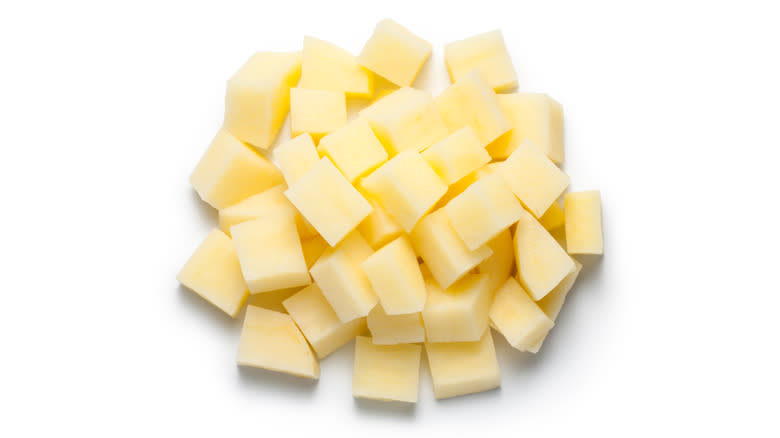
Cutting a starchy potato before boiling it might not be the best method to use; waxy potatoes are another story. They contain more moisture than the starchy kind, which helps them retain their shape and texture during boiling. This means cutting or peeling them will prevent them from mushiness, as might be the case with a starchy potato.
It is, therefore, advisable to use a waxy potato when trying Alton Brown's potato boiling hack, whether you're starting on a recipe for mashed potatoes, potato salad, or anything else. But that's only if you don't want to mess it up. In fact, Brown uses a russet, which is the epitome of a starchy potato, but his triangle trick seems to work nonetheless, probably because of the extensive trial and error process he describes in his YouTube video on the subject. The hack in question is to peel the potatoes, cut them into half-inch triangles, and boil them for 15-20 minutes. Brown explains that this shape and size allows the potatoes to reach the "perfect range of doneness and starch-gelatinization."
Reuse Your Cooking Water
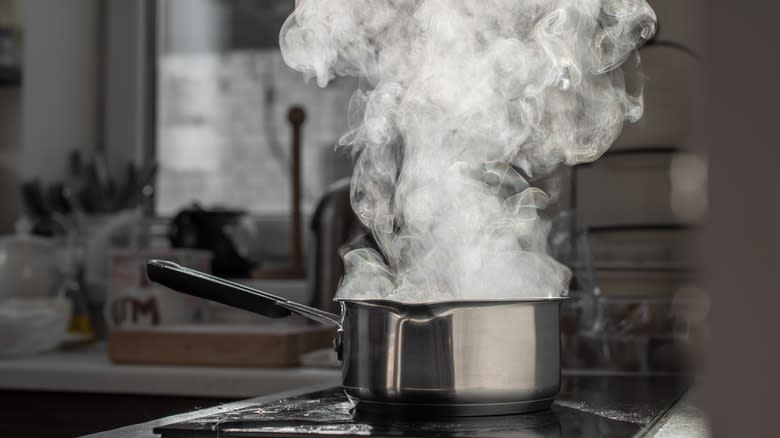
If you like to use every part of the animal, down to the skin and the feet, or save each inch of a vegetable for later use, including the peeled skin of a carrot, then you'll like our tip for reusing the cooking water from your boiled potatoes. Indeed, reserving this water is tantamount to using pasta water to embellish your pasta sauces — in both cases, you are relying on the starch that has transferred from the ingredient to the water to add texture to whatever else you're making.
For example, you can use water from your boiled potatoes to cut them once they're mashed, substituting it for some of the milk or cream you might otherwise add. Indeed, potato water can be used as a thickening agent in many different types of recipes. Next time you make gravy, for instance, use the water from your boiled potatoes (because if there's gravy, there should be potatoes somewhere nearby) to thicken it instead of cornstarch.
Salt The Water

When boiling anything, it's important to salt the water at some point during the process, or your ingredient will come out tasting thoroughly bland. This is true of potatoes as well, as it will take some time for the salt to reach the inside of a potato, and simply salting an already boiled potato on the outside won't cut it.
Rather, it is recommended to add a full cup of salt to the water, bearing in mind that a lot of that is going to get poured out again at the draining stage. A good dose of salt will ensure that enough of it seeps into the potatoes to keep them salty and tasty even after the addition of any butter or milk, as with mashed potatoes. Just be sure to add the salt at the right time. If you add it too late, you risk it coming up against a hard, impenetrable potato exterior, leaving most of the salt to float around in the water instead of being absorbed by the tuber. The best thing to do is salt the potato water at the beginning — this will allow the salt to penetrate the soft exterior of the potatoes and make its way to the middle unhindered.
Don't Boil Them In A Bag
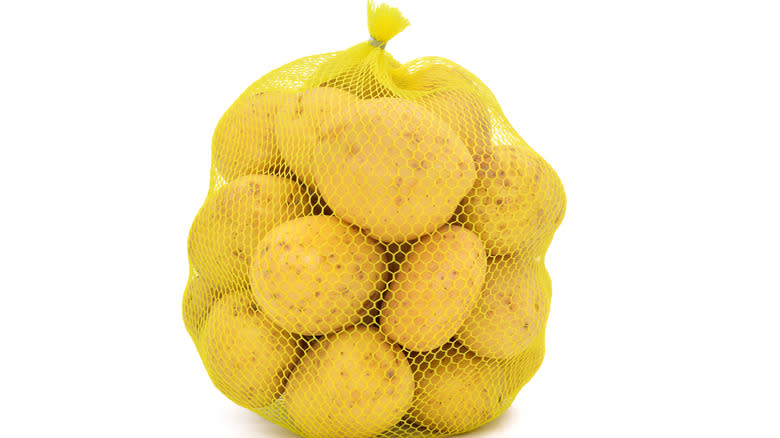
You may not need us to tell you that you should take the potatoes out of their bag before boiling them. In all likelihood, you've already figured that part out. But if you haven't, it's okay. You wouldn't be alone. In fact, an old TikTok video has recently crawled back out of the abyss whence it came to show a grown man, Carl Ruiz, dropping a bag and the potatoes it contains into a pot of boiling water.
This begs the question: Is that an actual thing? Does it work? Is it safe? Well, apparently, it's mostly fine if you don't mind some trace chemicals leaking into the water from the plastic or nylon mesh bag. But generally, it should be avoided if possible. The mesh is not there to allow water to reach the potatoes. It's there to allow air to reach them while they're still on the shelf or in your cupboard. It's there so you can see if the potatoes are all right because, more often than not, they won't be perfect, and they'll need some cleaning and de-spudding before going in the water, all of which definitely requires the removal of the bag.
Prep The Skin Before Boiling
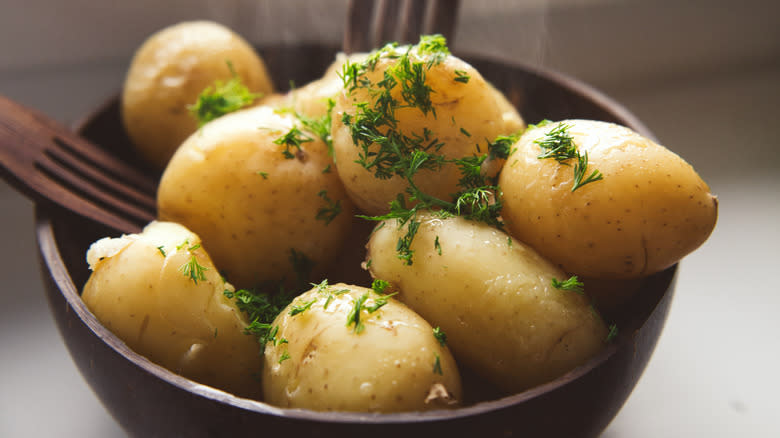
If you like to boil your potatoes and peel them afterward, as is advisable in many cases, you might run into the logistical problem of peeling hot potatoes. Even just holding a hot potato is no easy task, as evidenced by the classic children's game, never mind peeling one. But we have a solution you might like.
It will take a bit of forethought. Before you even boil the potatoes, you'll have to clean them and scrape off any dirt. Then, take a small knife and make an indentation around the widest circumference of the potato, probably in its midsection, ensuring it pierces through the skin a little but not too much, as you don't want the skin to fall off in the middle of the boiling process. Finally, once the potatoes are boiled and drained, look for that initial cut, pull on it, and slip the skin right off.
Pour In Some Baking Soda
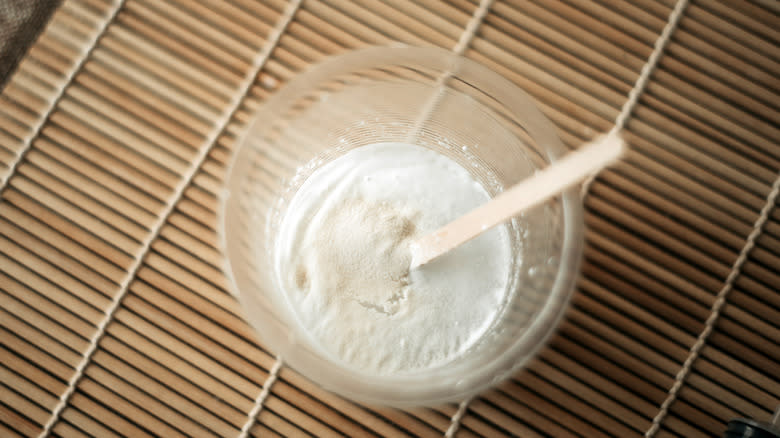
Whenever anyone sets out to make a roast potato, all they want — whether they admit it or not — is to achieve the perfect crispy bite. We can't make miracles happen, but we can certainly give you some advice on how to get closer to that goal. One especially effective trick is to parboil your potatoes with a bit of baking soda before putting them in the oven.
To make this work, all you have to do is throw some baking soda into your pot of boiling water along with the potatoes. The alkaline substance will cause a chemical reaction in the potatoes that will stay with them from the pot to the oven. Specifically, it will cause the edges of the potatoes to crumble more quickly, leading to cracks in the potato that will quickly turn into crunch once exposed to dry heat in the oven for those 20-30 minutes it takes to roast them.
Parboil Them Before Roasting
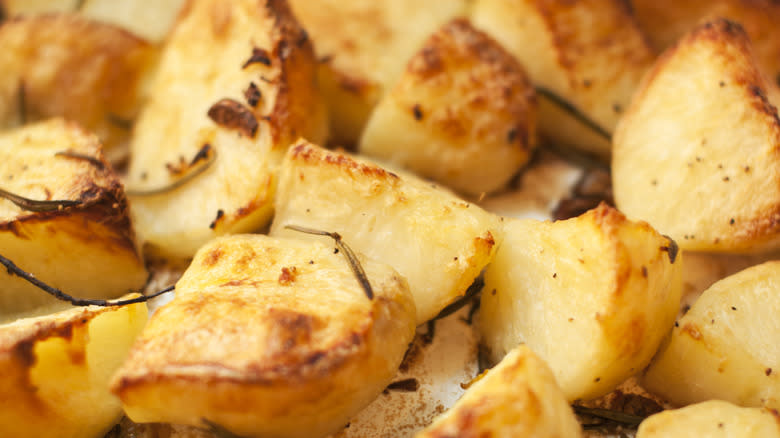
Dicing up a raw potato and putting it directly in the oven is the simplest way to roast a potato. Indeed, the potato will eventually cook that way. But it won't cook nearly as well as if you'd parboiled the potato first, for about 10-15 minutes or until the potatoes are tender. In particular, this step will help your roasted potatoes develop a nice and crispy exterior.
To make this happen, peel and cube your potatoes before parboiling them, whereupon they should develop a fairly thick layer of starch on the exterior -– this is the part that will go crispy in the oven, so the thicker, the better. If you find that your potatoes still don't come out crispy enough for your taste despite this extra step, then go ahead and smash them up a little as you transfer them from the pot to the roasting pan. Roughing them up will increase the surface area of the potato, creating more areas that can easily become crispy.
Dice Them Up For A Quick Parboil
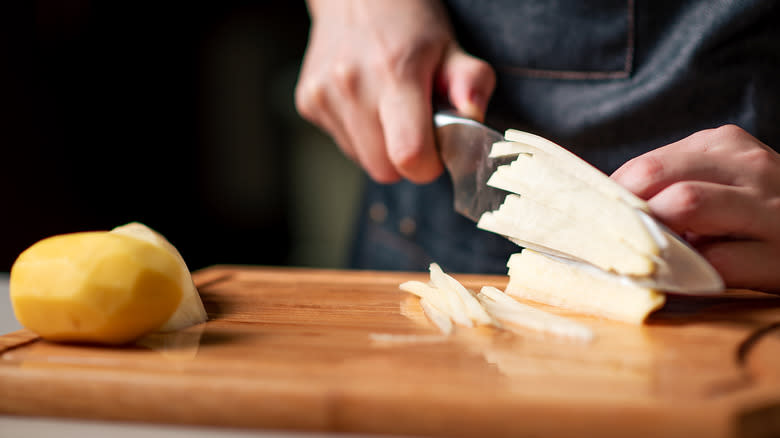
Potatoes are great at creating tasty, easy starches to fill the tummy at the dinner table, but sometimes, they can take far too long to cook, especially when you're using fresh ones. The solution to this conundrum, at least in terms of parboiling, is to simply dice up the potatoes into very small pieces. This will allow them to cook through in a much shorter time than if you were dealing with whole potatoes or larger pieces.
Now, you might think all this is obvious. Smaller pieces cook faster — everybody knows that. But the trick comes because of the method itself, more than with the size of the potatoes. In fact, rather than use a pot, you'll need to put the diced potatoes in a pan, upon which you will pour pre-boiled water directly from a kettle. At this point, the potatoes just need to simmer for five minutes, and you're done. Just bear in mind that the results will need some polishing, as this method really is just for parboiling. If you need a fully boiled potato for mashing, for example, you'll have to stick to more traditional methods.
Read the original article on Tasting Table.

